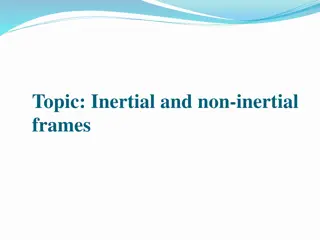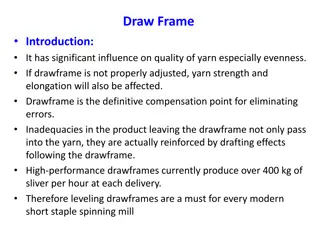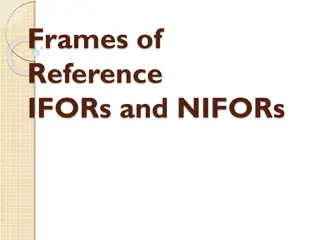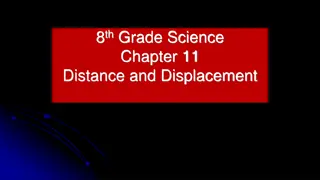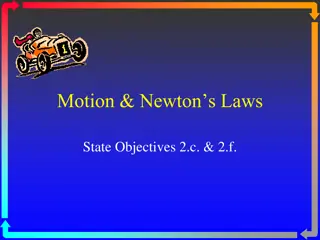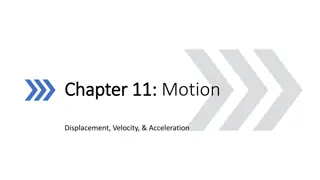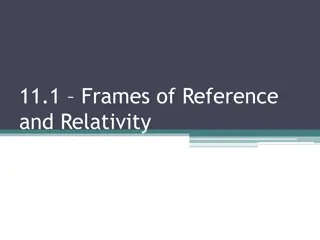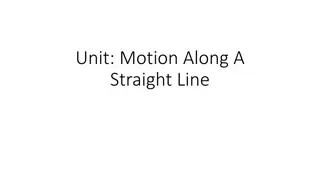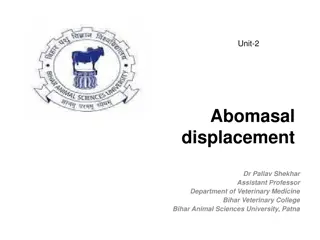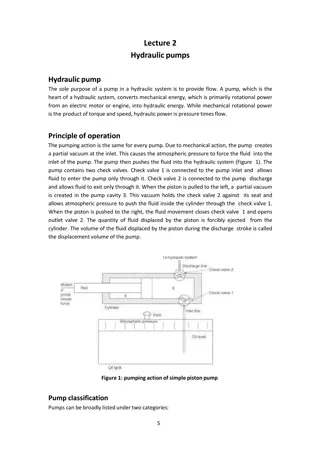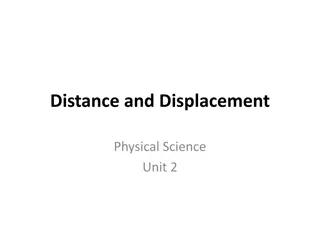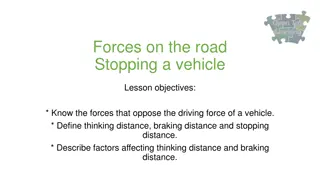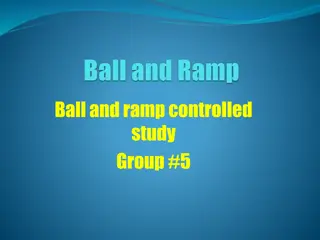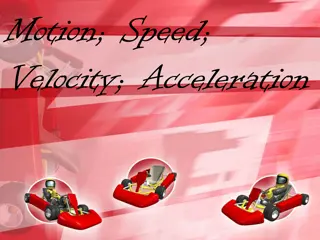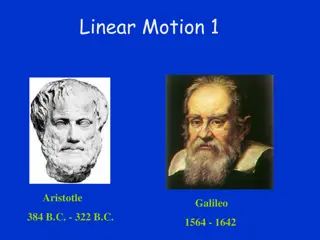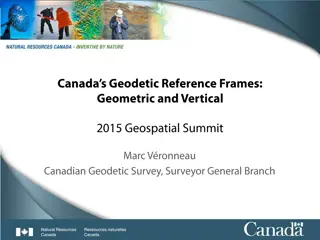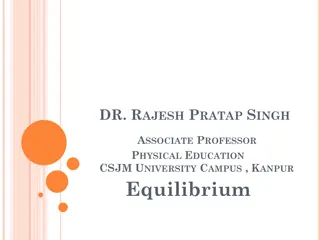Understanding Motion: Distance, Displacement, and Frames of Reference
This educational content delves into the concepts of motion, specifically distance, displacement, and frames of reference. It distinguishes between distance traveled and displacement, illustrating with examples of car journeys and runner movements. The importance of frames of reference in accurately describing motion is emphasized, along with thought-provoking scenarios about the perception of movement from various perspectives.
Download Presentation

Please find below an Image/Link to download the presentation.
The content on the website is provided AS IS for your information and personal use only. It may not be sold, licensed, or shared on other websites without obtaining consent from the author. Download presentation by click this link. If you encounter any issues during the download, it is possible that the publisher has removed the file from their server.
E N D
Presentation Transcript
P. Sci. Chapter 11 Motion
Motion when something changes position
Distance How far the object travels
Displacement the distance an object has been moved from one position to another
Example one car travels from one town to another that is 20 km to the east. X X 20 km
another car travels around a track for 20 km and ends up at the starting point. X
Both cars traveled a distance of 20 km but the first car s displacement is 20 km east while the second car s displacement is 0 km because it ended up where it started from.
Frame of reference To describe motion accurately and completely, a frame of reference is necessary. Frame of reference is a system of objects that are not moving with respect to one another.
If you are standing beside the tree on the left what is moving? If you are on the train what is moving? If you are riding down the road on a buss is your friend moving beside you? Are the road signs moving?
If you are on the plane what is moving from your frame of reference? If you are beside the tree what is moving from your frame of reference?
Displacement vs. Distance Distance is the total length traveled Displacement is the distance measured directly from starting to stopping point. What is the distance traveled on the path below? What is the displacement?
A runner leaves his house and runs two blocks east, then three blocks south and finally 1 block west. How far has the runner traveled? What is his displacement? What is the distance traveled of a race car driver in the Indy 500? What is the displacement of a race car driver in the Indy 500?
Speed How much time it takes for a change in position to occur or how fast something moves.
Any change over time is called a rate. Speed is the rate of change in position or the rate of motion.
Kinds of Speed 1. Instantaneous Speed the rate of motion at any given instant. (speedometer)
2. Constant Speed a speed that does not vary.(cruise control)
3. Average Speed is the total distance traveled by total time of travel. (miles per hour)
Formula for speed: d s = t
Velocity is both speed and direction Like speed, velocity may change Unlike speed, the velocity can change while the speed stays constant (Because velocity includes both speed and direction, if either value changes, velocity will change )
Formula for velocity: d (in a certain direction) v = t
Terminal velocity the highest velocity that will be reached by a falling object.
Magic Triangle with units Distance (meters) Time (seconds) Speed (m/s)
Velocity and speed Both are calculated by dividing distance by time. Velocity = distance/time speed= distance/time Velocity had a direction, speed does not. UNITS of speed and velocity is meter/second or kilometer/hour 1. A runner ran 400 meters for 40 seconds. At what speed did he run? Given: 400 m = distance 40 s = time ?? = speed s t Solve ? =400? d = 40? S = 10 m/s
Velocity and speed 2. What is the speed of a bobsled whose distance-time graph indicates that it traveled 150 m in 25 s? Given: 150 m = distance 25 s = time ?? = speed Solve ? =150? d = 25? t s S = 6 m/s
Velocity and Speed 3. A runner traveling at 4.25 m/s will travel how far in 23 s? Given: 4.25m/s = speed 23 s = time ?? = distance Solve ? = 4.25? ? 23 ? = d d = 97.75 m t s
Velocity and Speed 4. How long will it take a runner going 4.25 m/s to travel 50.0 meters? Given: 4.25 m/s = speed 50.0 = meters ?? = time Solve t =50.0 ? 4.25? d = ? t s t = 11.76 s
Graphing Speed A distance-time graph is a good way to describe motion The slope of a line on a distance-time graphs is speed
What is the objects average speed? What is it s speed between 6s and 10 s? When is it traveling the fastest? When is it NOT moving?
Where is the object standing still? Where is the object traveling backwards? Where is the object traveling at 5m/s? What is speed at line E?
Acceleration the rate of change of velocity. Acceleration is both the rate of change in velocity and the direction of that change. So, even if an objects speed remains constant acceleration occurs if the direction changes.
Acceleration (cont.) IF: an object travels in a straight line acceleration is just the rate of change of speed. the acceleration is in the same direction as the velocity (change of direction) then the object speeds up. the acceleration is in the opposite direction from velocity then the object slows down.
To calculate average acceleration, divide the change in velocity by the time interval. vf - vi v a = t = t Where: a = average acceleration vf = final velocity vi = initial (starting) velocity t = time = a greek symbol for delta (change) and it stands for change in v = change in velocity vf - vi t a
Acceleration The change in velocity over time. Or the change in speed or direction ???????????? =????? ???????? ?????? ???????? ????
Acceleration cont. If acceleration is small speed change is gradual If acceleration is large speed change is rapid.
Acceleration cont. Positive acceleration = object is speeding up Negative acceleration = object is slowing down
D. Calculations Your neighbor skates at a speed of 4 m/s. You can skate 100 m in 20 s. Who skates faster? GIVEN: d = 100 m t = 20 s v = ? v = 5 m/s d t WORK: v = d t v = (100 m) (20 s) You skate faster! v
D. Calculations A roller coaster starts down a hill at 10 m/s. Three seconds later, its speed is 32 m/s. What is the roller coaster s acceleration? GIVEN: vi = 10 m/s t = 3 s vf = 32 m/s a = ? a= 7.3 m/s2 a t WORK: a = (vf- vi) t a = (32m/s - 10m/s) (3s) a = 22 m/s 3 s vf - vi
D. Calculations Sound travels 330 m/s. If a lightning bolt strikes the ground 1 km away from you, how long will it take for you to hear it? GIVEN: v = 330 m/s d = 1km = 1000m t = ? t = 3.03 s d t WORK: t = d v t = (1000 m) (330 m/s) v
D. Calculations How long will it take a car traveling 30 m/s to come to a stop if its acceleration is -3 m/s2? GIVEN: t = ? vi = 30 m/s vf = 0 m/s a = -3 m/s2 t = 10 s a t WORK: t = (vf- vi) a t = (0m/s-30m/s) (-3m/s2) t = -30 m/s -3m/s2 vf - vi
E. Graphing Motion Distance-Time Graph slope = speed A steeper slope = faster speed B straight line = constant speed flat line = no motion
E. Graphing Motion Distance-Time Graph Who started out faster? A (steeper slope) Who had a constant speed? A Describe B from 10-20 min. B stopped moving Find their average speeds. A = (2400m) (30min) A = 80 m/min B = (1200m) (30min) B = 40 m/min A B
E. Graphing Motion Distance-Time Graph Acceleration is indicated by a curve on a Distance-Time graph. 400 300 Distance (m) 200 Changing slope = changing velocity 100 0 0 5 10 15 20 Time (s)
E. Graphing Motion Speed-Time Graph slope = + = speeds up - = slows down acceleration 3 2 Speed (m/s) straight line = constant accel. 1 flat line = (constant velocity) no accel. 0 0 2 4 6 8 10 Time (s)
E. Graphing Motion Speed-Time Graph Specify the time period when the object was... slowing down 5 to 10 seconds speeding up 0 to 3 seconds 3 2 Speed (m/s) moving at a constant speed 3 to 5 seconds not moving 0 & 10 seconds 1 0 0 2 4 6 8 10 Time (s)



